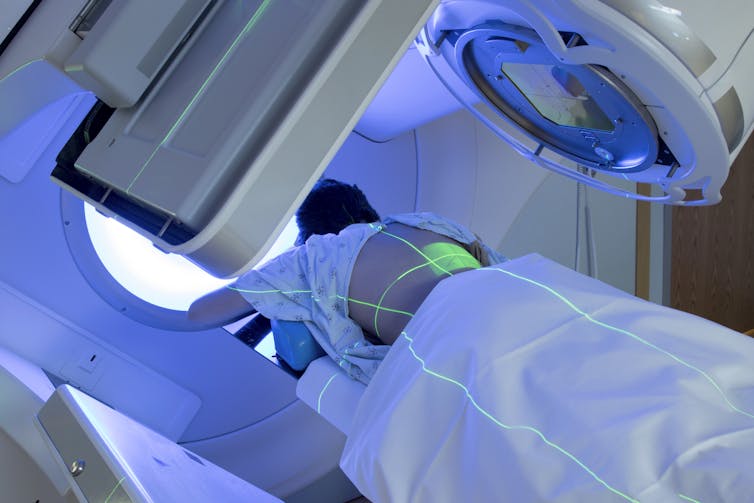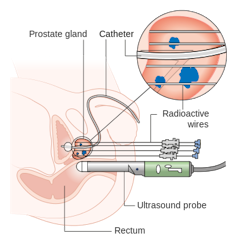
Nearly half of all cancer patients undergo radiation therapy as part of their care. Ionizing radiation, or the emission of high-energy waves or particles, works as a therapy by damaging a cancer cell’s DNA. It’s an effective tool for killing cancer cells because they are generally much less adept at DNA repair compared to healthy cells. Damaging specific parts of DNA prevents cancer cells from reproducing, effectively killing them.
A major limitation of radiation therapy is the damage it may cause as it passes through healthy organs to get to tumors located deep in the body. The need to protect healthy organs limits the dose of radiation that can be delivered to cancerous tissue, thereby reducing the chance of successful treatment.
Overcoming this challenge has long been a mission for medical physicists and radiation oncologists like us. Improvements to radiotherapy will enable clinicians to not only better control tumors overall, but also open the door for more favorable outcomes in patients with cancers that are more resistant to radiation.
Fundamentals of radiation therapy
At the heart of radiation therapy lies the fundamental principle that cancer cells are more susceptible to radiation than healthy cells. However, there are exceptions. Sometimes resistance to radiation in cancer cells may be comparable or even greater than that of their neighboring cells.
When tumors lie close to vital organs that are highly sensitive to radiation, such as the brain or the bowels, it significantly limits the amount of radiation that can be delivered. In cases where tumors are significantly less sensitive to radiation than the organs surrounding it, radiotherapy may not be the best choice.
Patient immobilization is another key aspect to reducing toxicity from radiation. Patients need to be completely motionless during treatments to ensure that the beam of radiation mainly targets tumors and not the healthy tissues surrounding them. If a patient moves during treatment, it can mean the radiation beam is partly or even entirely missing the cancer target. This scenario both underdoses the cancer and increases the risk of harming healthy tissue.
There are a few common types of radiotherapy that deliver radiation in different ways:
External beam radiation therapy
External beam radiation involves directing radiation from an outside source to a single part of the body.
Linear accelerators, commonly referred to as LINACs, are currently the most common technology used in radiation treatments. These machines generate beams of high-energy electrons and X-rays that can be aimed at cancer tissue with precision. The high energy of these beams allows in-depth penetration into the body to reach tumors.
Another form of radiotherapy is proton beam therapy, or PBT, which directs protons instead of X-rays at tumors. Currently, PBT is only available at a limited number of locations. It is typically recommended for specific populations such as pediatric patients because, unlike X-rays, it has an adjustable range that minimizes the effects of radiation on organs beyond the target area, potentially reducing toxicity.
Image-guided radiation therapy
In the early 2000s, researchers incorporated CT scanners into LINACs. This enabled real-time imaging of the patient’s anatomy just before or during treatment. By acting as the eyes of the care team, imaging reduced uncertainty about the location of tumors and improved the precision and accuracy of radiation therapy.
Newer linear accelerators are now incorporating MRIs, which significantly improve visualization of patient anatomy and tumors, further advancing treatment precision and accuracy.

Researchers are also adding positron emission tomography, or PET, scanners that provide information about the metabolic function of tumors. This advance makes it possible to increase the radiation dose specifically at the most active areas of tumors.
Adaptive therapy
An emerging approach to radiation therapy called adaptive therapy uses imaging to dynamically adjust treatment as the tumor or its positioning changes each day.
In conventional radiation therapy, patients receive the same treatment plan across multiple treatment sessions. However, adaptive therapy may apply several adjustments or lead to a completely new treatment plan in order to address changes to the tumor’s condition over the course of treatment.
Historically, the concept of adaptive therapy was more theoretical than practical. It faced many challenges, including a lack of suitable imaging technologies. Additionally, creating a treatment plan involves heavy computational work and collaboration among various specialties within a care team. The fact that the process needs to be repeated multiple times renders adaptive therapy particularly resource-intensive and time-consuming. However, researchers are looking into ways to use artificial intelligence to automate some of these steps to make this approach more practical.
Brachytherapy
Brachytherapy – stemming from the Greek word “brachys,” meaning “short” – is another widely used method in radiation therapy. It involves placing a radioactive source called a seed near or directly inside a tumor or affected area, reducing the distance from the radiation source to its target.
In contrast to external beam radiation therapy, where radiation often must pass through healthy tissue to reach cancer cells, brachytherapy applies radiation directly to the tumor. This technique is particularly advantageous for certain cancer types that are accessible through noninvasive or minimally invasive procedures, such as skin cancers, gynecological tumors and genitourinary tumors.

The conventional approach to brachytherapy involved using needles to place or inject radioactive seeds inside or adjacent to the cancerous tissue. These seeds would remain in the body either temporarily or permanently, with the goal of irradiating the area at a low dose over a long period of time.
An increasingly popular form of brachytherapy called high-dose rate brachytherapy involves using a tube to guide a more highly radioactive seed directly to the affected tissue before removing it after a few minutes. The seed emits a high dose of radiation in a short period of time, which enables clinicians to treat patients quickly in an outpatient setting.
Future of radiation therapy
Radiation therapy is continually evolving to more effectively and precisely treat cancer.
For example, a technique that delivers radiation at an ultra-high rate called FLASH-RT has shown promise in its ability to increase dosages without excessive toxicity. Researchers are also exploring treatments using ions heavier than protons to more effectively damage DNA in cancer cells and enhance the efficacy of radiation therapy.
Advances in the field hint at a future of more personalized radiation therapy, highlighting the fusion of technology and medical expertise in the fight against cancer.
The authors do not work for, consult, own shares in or receive funding from any company or organization that would benefit from this article, and have disclosed no relevant affiliations beyond their academic appointment.
This article was originally published on The Conversation. Read the original article.







